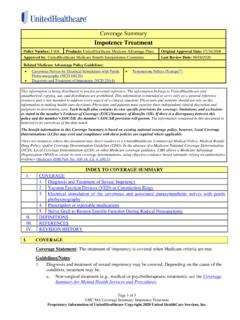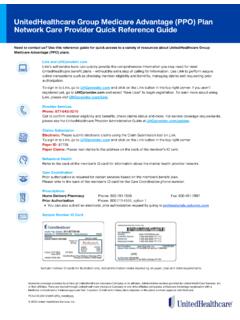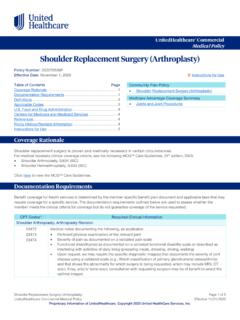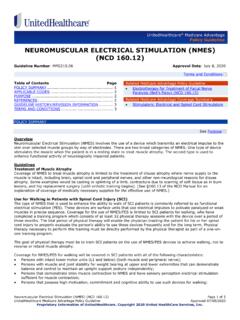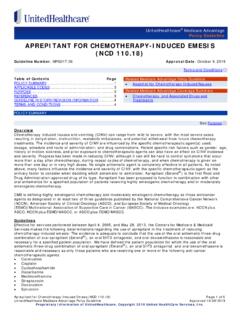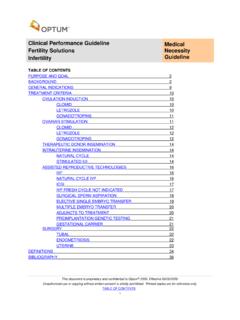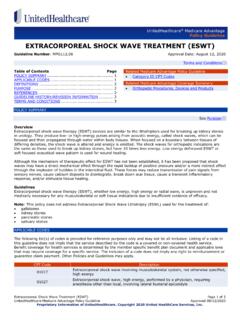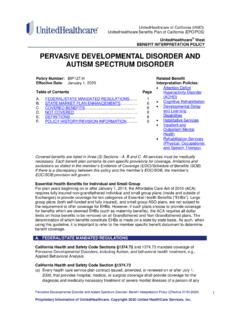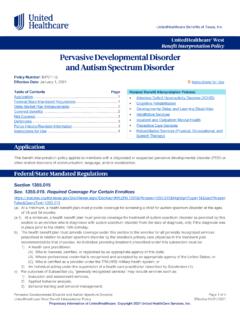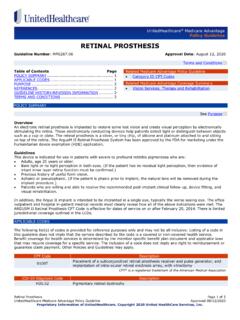Transcription of Avastin® (Bevacizumab) – Medicare Advantage Policy Guideline
1 Avastin (Bevacizumab) Page 1 of 25 UnitedHealthcare Medicare Advantage Policy Guideline Approved 07/14/2021 Proprietary Information of UnitedHealthcare. Copyright 2021 United HealthCare Services, Inc. UnitedHealthcare Medicare Advantage Policy Guideline Avastin (Bevacizumab) Guideline Number: Approval Date: July 14, 2021 Terms and Conditions Table of Contents Page Policy Summary .. 1 Applicable Codes .. 4 Definitions .. 21 References .. 22 Guideline History/Revision Information .. 23 Purpose .. 24 Terms and Conditions .. 25 Policy Summary See Purpose Overview Bevacizumab is a monoclonal antibody produced by recombinant DNA technology in Chinese hamster ovaries.
2 This monoclonal antibody binds to and inhibits the biologic activity of human vascular endothelial growth factor preventing the formation of new blood vessels. Guidelines As published in CMS Program Integrity Manual, Section , in order to be covered under Medicare , a service shall be reasonable and necessary. Drugs and biologicals must be determined to meet the statutory definition under the statute 1861(t) (1). Medicare Benefit Policy Manual Pub. 100-02, Chapter 15, Section 50, describes national Policy regarding Medicare guidelines for coverage of drugs and biologicals.
3 Generally, drugs and biologicals are covered only if all of the following requirements are met: They meet the definition of drugs or biologicals; They are of the type that are not usually self-administered by the patients who take them; They meet all the general requirements for coverage of items as incident to a physician's services; They are reasonable and necessary for the diagnosis or treatment of the illness or injury for which they are administered according to accepted standards of medical practice; They are not excluded as immunizations; and Related Medicare Advantage Policy Guidelines Coverage of Drugs and Biologicals for Label and Off-Label Uses Self-Administered Drug(s) (SAD) Related Medicare Advantage Reimbursement Policies Discarded Drugs and Biologicals Policy , Professional National Drug code (NDC) Requirement Policy , Professional and Facility Related Medicare Advantage Coverage Summaries Chemotherapy, and Associated Drugs and Treatments Vision Services, Therapy and Rehabilitation Avastin (Bevacizumab)
4 Page 2 of 25 UnitedHealthcare Medicare Advantage Policy Guideline Approved 07/14/2021 Proprietary Information of UnitedHealthcare. Copyright 2021 United HealthCare Services, Inc. They have not been determined by the FDA to be less than effective. Coverage for medication is based on the patient's condition, the appropriateness of the dose and route of administration, based on the clinical condition, medical necessity and the standard of medical practice regarding the effectiveness of the drug for the diagnosis and condition. The drug must be used according to the indication and protocol listed in the accepted compendia listed below.
5 National Comprehensive Cancer Network (NCCN) Drugs and Biologies Compendium American Hospital Formulary Service-Drug Information (AHFS-DI) Thomson Micromedex DrugDex Clinical Pharmacology Wolters Kluwer Lexi-Drugs The compendia employ various rating and recommendation systems that may not be readily cross-walked from compendium to compendium. Note: It is not appropriate to bill for services that are not covered (as described by this entire Policy Guideline ) as if they are covered. When billing for non-covered services, use the appropriate modifier.
6 If a medication is determined not to be reasonable and necessary for diagnosis or treatment of an illness or injury according to these guidelines, the entire charge will be excluded ( , for both the drug and its administration). Also excluded from payment is any charge for other services (such as office visits) which are primarily for the purpose of administering a non covered injection ( , an injection that is not reasonable and necessary for the diagnosis or treatment of an illness or injury). Cancer Use of the drug or biological must be safe and effective and otherwise reasonable and necessary.
7 Drugs or biologicals and cancer chemotherapeutic agents approved for marketing by the Food and Drug Administration (FDA) are considered safe and effective for purposes of this requirement when used for indications specified on the labeling. Therefore, payment may be made for an FDA-approved chemotherapeutic drug or biological, if: It was injected on or after the date of the FDA's approval; It is reasonable and necessary for the individual patient; and All other applicable coverage requirements are met. An unlabeled use of a drug is a use that is not included as an indication on the drug's label as approved by the FDA.
8 FDA approved drugs used for indications other than what is indicated on the official label may be covered if the contractor determines the use to be medically accepted, taking into consideration the major drug compendia, authoritative medical literature and/or accepted standards of medical practice. There are many reasons to consider an unlabeled use for a cancer chemotherapy agent. Some of these are: Drugs may be effective for many other cancers in addition to the ones that were considered in the primary labeling of the drug. Many chemotherapeutic agents are given in combinations.
9 Any one of the drugs in the combination may not have been approved in the initial labeling of the products. In addition the combination of effective chemotherapeutic agents changes over time. Cancer chemotherapeutic agents are always changing and improving over time. Oncologists are often left with few approved treatment options if initial treatment regimens have failed. Coverage Bevacizumab (Avastin ) is a vascular endothelial growth factor inhibitor indicated for the treatment of: (Refer also to the NCCN Compendium for additional off-label indications) Metastatic colorectal cancer o In combination with intravenous fluorouracil-based chemotherapy as first or second-line treatment o In combination with fluoropyrimidine-irinotecan- or fluoropyrimidine-oxaliplatin-based chemotherapy for second-line treatment in patients with metastatic colorectal cancer who have progressed on a first-line Avastin Avastin (Bevacizumab)
10 Page 3 of 25 UnitedHealthcare Medicare Advantage Policy Guideline Approved 07/14/2021 Proprietary Information of UnitedHealthcare. Copyright 2021 United HealthCare Services, Inc. Non-small cell lung cancer o First-line treatment in combination with paclitaxel and carboplatin for unresectable, locally advanced, recurrent or metastatic non-squamous cell disease Recurrent glioblastoma in adults Metastatic renal cell carcinoma in combination with interferon alfa Cervical cancer o In combination with either a) paclitaxel and cisplatin or b) paclitaxel and topotecan in persistent, recurrent, or metastatic disease Epithelial ovarian, fallopian tube, or primary peritoneal cancer o In combination with paclitaxel, pegylated liposomal doxorubicin, or topotecan for platinum-resistant recurrent disease who received no more than 2 prior chemotherapy regimens o In combination with carboplatin and paclitaxel, followed by Avastin as a single agent, for stage III or IV disease following initial surgical resection o In combination with carboplatin and paclitaxel or carboplatin and gemcitabine.
